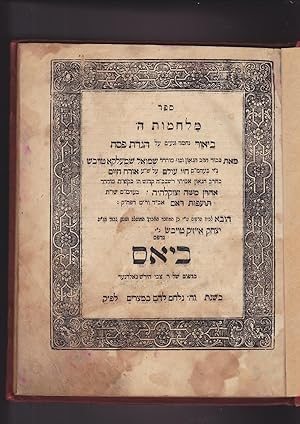haggadah (Mehr als 2.000 Ergebnisse)
Produktart
- Alle Produktarten
- Bücher (2.034)
- Magazine & Zeitschriften (2)
- Comics (1)
- Noten
- Kunst, Grafik & Poster (2)
- Fotografien
- Karten
-
Manuskripte &
Papierantiquitäten (1)
Zustand
Einband
Weitere Eigenschaften
Gratisversand
Land des Verkäufers
Verkäuferbewertung
-
The Haggadah.
Verlag: London: Beaconsfield Press, 1940, 1940
Anbieter: Peter Harrington. ABA/ ILAB., London, Vereinigtes Königreich
Erstausgabe
First Szyk edition, number 59 of 125 copies printed on vellum, signed by both illustrator and editor, and released for sale in the United States. The most lavishly produced modern edition of the Haggadah, this was Szyk's magnus opus, drawing a striking visual parallel between the Passover narrative of oppression in ancient Egypt and the alarming development of anti-Jewish activities in Nazi Germany. The Polish-born Jewish artist Artur Szyk (1894-1951) was known in the 1930s for his political cartoons, the most famous of which depicted Hitler as an ancient Egyptian pharaoh; his art had become more politically engaged after Hitler took power in Germany in 1933. Szyck's choice of the Haggadah as a new subject, other than the artistic possibilities that it offered, was motivated by the thematic significance of the text as a reminder of past Jewish triumphs over persecution. "While the miniature paintings depict historical scenes, in the text illuminations Szyk has combined figures in historical costume, characters from the east European ghetto, and young Jewish pioneers in Palestine. These figures illustrate a continuum, making the point that the struggle for freedom cannot be relegated to the past but is very much a current and contemporary concern" (Ansell, p. 93). The monumental collection of illustrations took Szyk several years to complete. When he presented the work to potential publishers around 1937, many rejected it; this was partly due to the challenge of reproducing the artist's fine detail and vibrant colours, and partly due to the explicitly anti-Nazi subject matter, as the illustrations depicted the Egyptians, snakes, and other vicious animals decorated with swastikas. However, the Beaconsfield Press was founded by several prominent members of the Jewish community in England with the express purpose of publishing Szyk's project; the corporation was named in honour of Benjamin Disraeli, earl of Beaconsfield. In the final version, the swastikas were removed, but Szyk's message was remarked in the introduction, in which the editor and translator Cecil Roth, renowned historian of Judaism, emphasizes the parallels drawn by the artist between the historical tale and present-day political issues. The book was printed in 1939, then bound and published in 1940. It enjoyed a great success and was hailed by The Times as "worthy to be placed among the most beautiful of books that the hand of man has produced". A further 125 copies, also printed on vellum and signed, were issued for distribution in England. Joseph P. Ansell, Arthur Szyk: Artist, Jew, Pole, 2004; "The Haggadah - A Sumptuous Illustrated Edition", The Times Literary Supplement, 22 Feb. 1941. Large quarto, comprising 118 french-fold leaves. Original blue morocco by Sangorski & Sutcliffe, spine with raised bands, compartments framed in gilt enclosing gilt lettering and crown tools, triple gilt fillet border to covers, large illustration of high priest holding the matzoh and Passover wine as centrepiece, board edges and turn-ins tooled in gilt, doublures of cream silk satin illustrated with Moses supporting the Ten Commandments. Housed in the original velvet-lined blue half morocco solander box, blue morocco label with lion's head design in gilt to front board. Text in Hebrew and English. Printed in black, purple, blue, red, and green on vellum. With 14 full-page plates and numerous vignettes and border decorations printed in colour, all by Szyk. The box with couple of spots of wear at extremities, some marks and toning to cloth, couple of scratches, still presenting well. A fine copy in the handsome original binding.
-
The Haggadah: A New Critical Edition with English Translation, Introduction, and Notes Literary, Historical, and Archaeological
Verlag: Soncino Press, London, 1930
Anbieter: Bromer Booksellers, Inc., ABAA, Boston, MA, USA
Signiert
Rutherston, Albert (illustrator). Small quarto. xl, (3), 209pp. One of nine copies printed on Roman Vellum, signed by the editor, Cecil Roth, and the illustrator, Albert Rutherston. With fourteen full-page stencilled illustrations, plus seventy small ornaments, all in color. Rutherston's bright depictions of the Passover story, including illustrations of the Jews under Pharaoh, the parting of the Red Sea, the Ten Commandments, and the prophets looking over modern children at play, bring both joy and gravity to the sacred text. Rutherston collaborated with the Curwen Press repeatedly over his career, and this is perhaps one of his most accomplished works, possibly influenced by his years in Palestine while serving in the British Army. Set in Roman and Italic English type, as well as Hebrew type purchased from Enschedé en Zonen in Holland, the edition embraces the tradition of the pictorial Haggadah while imbuing it with modernity. A Western title page appears at the front of the volume when opened left to right, followed by a publisher's note and an Introduction by Roth describing the historic and spiritual place of the Haggadah. The rest of the volume reads right to left, with Hebrew at the right hand and English translation and glosses at the left. The result is an inviting, impressive edition, beautiful to the layperson and the intitiated. Bound in full green morocco by Henry T. Wood, Ltd., a progressive London firm whose exceptional giltwork is on display here in the tooled depiction of candles and the Torah at the Western lower cover, ruling to inner and outer edges and spine bands, and spine titles in Hebrew and English. Metal clasps. Some soiling to exterior, inconsequential stain to lower corner of text block, else fine. A remarkable production. Bookplate of Anne and Robert H. Siskin, prominent members of the Jewish community of Chattanooga, Tennessee, who founded the Siskin Steel Company and whose fortunes established the Siskin Children's Institute and Siskin Hospital for Physical Rehabilitation. (A Spirit of Joy, p. 28).
-
A Supplement to the Haggadah for Passover
Verlag: Histradut Zionit, Achida, and Nocham, Munich, 1946
Anbieter: Bromer Booksellers, Inc., ABAA, Boston, MA, USA
Adler, Miklós and Yosef Dov Sheinson (illustrator). Octavo. 14ff. With seven woodcuts by Miklós Adler. Text in Hebrew and Yiddish. Light spotting on back cover, else a very fine copy in printed wrappers. The history of this Haggadah begins with the compelling story of Hungarian-born Jewish artist Miklós Adler, whose family had endured the occupation and brutality of the Nazis. Between March 1944 and May 1945, more than half a million Jews of Hungary were killed. After living in Debrecen's Jewish ghettos and being marked for transport to Auschwitz, the Adler family was moved to Thieresenstadt, the concentration camp outside Prague. In May of 1945, the Adler family survivors returned to Hungary, and Miklós created sixteen vivid and emotive woodcuts depicting atrocities of the Holocaust, arranged in the order in which the events occurred and numbered to correspond to this chronology. The first five images elucidated Adler's personal experience with the Nazi invasion of Hungary, while images six through sixteen depicted a more collective experience of the Holocaust and Auschwitz. Late in 1945, Szabadság Nyomda, known as the "Freedom Press," published a portfolio of Adler's sixteen woodcuts in an edition of 1,000 copies. Then referred to as "The Sufferings," the edition contained no title and no colophon. Each copy consisted of twenty-one loose sheets comprising the woodcuts, a preface in Hungarian and Hebrew, a preface in English and Russian, a sheet of captions in all four languages, and an epigraph. Adler 's name was not mentioned as the woodcut artist, but he did sign a few of the plates with two Hebrew letters to identify himself as the son of Benjamin. In the Hungarian edition's preface, Adler writes, "one can't find a word to apply to what happened to the Jews of Europe during the past years." Perhaps this is why Adler chose to tell this story using practically no words at all. By late 1945 to early 1946, the portfolio and its loose sheets were beginning to surface in the American zones near Munich. Yosef Dov Sheinson, a Lithuanian author and Hebrew teacher, apparently saw Adler's portfolio and incorporated seven of the sixteen images into the Haggadah he was editing, illustrating, and arranging for the first Passover after liberation. According to Touster, this Haggadah "did not just tell the traditional Passover story of Israel's deliverance from slavery under Pharaoh, but the parallel story of the Jewish remnant that survived slavery and destruction under Hitler." It was written for and dedicated to the "Saved Remnant, the few who escaped." After a devastation that sought to wipe out traces of anything Jewish, it was impossible to find Hebrew type in Lithuania, but according to Touster, Sheinson was able to secure the type with the benevolence of American Jewish organizations by November 1945. The director of Achida, one of the organizations involved in the printing of this Haggadah, brought paste-up pages to a major Munich publishing house, whose previous owners had been vehemently pro-Hitler. They created the plates and printed the first copies -- the present copy being among them. These initial copies were brought to U.S. Army chaplain Abraham J. Klausner, who suggested that these Haggadot be used for the upcoming Passover Seder. This work was then reprinted by the U.S. Third Army and used for a communal Seder in Munich on April 15 and 16, 1946. Emblazoned with the Third Army's tricolor insignia "A" and containing an English title page, epigraph, two-page introduction by Klausner, and a little re-arranging, the "A" Haggadah took on another life. Unlike the "A" Haggadah, our earlier copy mentions the Jewish organizations that contributed to its publication on the front cover. Ironically, Adler and Sheinson were both at Thieresenstadt during its first days of liberation. Adler, who immigrated to Israel in 1957, never knew about the use of his woodcuts in Sheinson's Haggadah. Thus, the identity of the artist of this Haggadah remained unknown until 1998, when conclusive scholarship became available on the Army reprint and Miklós Adler. The Sheinson Haggadah is most powerful for its interplay of text and image. Against a backdrop of Sheinson's hand-drawn depictions of Eden are Adler's purely dark reminders of the fallen world -- death marches, crematoria, separation from loved ones. In the borders, Sheinson's other illustrations include "braus bad," or gas showers; fathers debating with their sons; and the Promised Land blossoming with flowers and trees and fruits of the soil. Sheinson selectively altered the text to reflect a feeling of bitterness, which is most explicit in his treatment of the Dayenu, a hymn of praise. Adler's last image features a newly liberated man whose mind is anything but free as he struggles with what it means to go home. Together with a copy of the Third Army edition. OCLC records only three copies of the "A" Haggadah and no copies of this original printing. (Touster, A Survivor's Haggadah, p. xxv; Touster, Beyond Words, p. 18; Yaari 2328; not mentioned in Yersushalmi).
-
Seder Hagada [Haggadah hagadah] shel Pesakh [Pesach Pessach Pesah]
Verlag: Printed at the press of Chaim ben Zvi Hirsch. Undated (c. 1737-1767), Furth (Fuerth) Germany, 1767
Anbieter: Meir Turner, New York, NY, USA
Buch
Hardcover. Zustand: Very Good. In Hebrew. Yudlov 178. Yaari 2626. 24 leaves. Complete. With eight illustrations. OCLC: Libraries worldwide that own item: 2. The rules and the hymns Adir Hu, Ekhad mi Yode'a and Khad Gadya, are written in Judeo German using the Tze'ena Ure'ena font type. The printer Chaim ben Hirsch was active between 1737 and 1772. Chaim's father, Zvi Hirsch is followed by a blessing made to a living person. Zvi Hirsch died 17th Iyar 5527 (= 1767 C.E.), so this haggadah must have been published between 1737 and 1767. In 1769 Chaim ben Hirsh printed a similar Haggadah in Fuerth without the illustrations.
-
Haggadah for Passover, Copied and Illustrated by Ben Shahn.
Erscheinungsdatum: 1966
Anbieter: Henry Sotheran Ltd, London, Vereinigtes Königreich
Signiert
The Trianon Press, 1966. 80 leaves. Large, unbound folio in stiff, glassine covered wrappers, housed in large, vellum box, stamped with gilt lettering on front, back, and spine, with double clasp closure. Includes two extra sets of coloured plates, one on Japanese Nacre hand-made paper, and one on Arches Grand Velin, a set of uncoloured plates on Arches Verge paper, a series of progressive stages in the hand-stencil colouring of a single plate, three each of the original guide-sheets and stencils, and two proof states of the frontispiece. In addition, there is an original illustration from "An Only Kid". Fine condition. One of 10 copies numbered A to J, with this being J. Signed and stamped with the artist's cypher on the frontispiece. Ben Shahn (1898-1969) enjoyed a long career as a social realist artist and left wing visionary. Widely recognized for his murals, paintings, commercial illustrations and photography, he collaborated with Diego Rivera and undertook commissions for the Farm Security Administration. Perhaps his most famous work, the Jersey Homesteads Mural, has also been linked to the Haggadah and the themes of slavery, the struggles of immigrants, deliverance and redemption, which were important throughout his career.
-
Passover Service Munich Enclave MUSAF LE-HAGGADAH SHEL PESACH (SUPPLEMENT TO THE PASSOVER
Verlag: Munich, Germany, 1946
Anbieter: Meir Turner, New York, NY, USA
Buch
Soft cover. Zustand: Very Good. seven woodcuts by Miklos Adler (ben Benjamin), further page illustrations and border illustrations by Y.D. Sheinson (illustrator). In Hebrew and English. 8 1/4 x 5 ¾ in.; 210 x 145 mm. Original paper wrappers emblazoned with prominent red white and blue insignia of the U.S. Third Army, a blue disc with red border, the blue area bearing throughout a white capital letter "A." Most of the text in this haggadah is the work of Yosef Dov Sheinson - a survivor of the Kovno Ghetto, who augmented the traditional Passover Seder service with words that emanated from the anguished souls of the survivors themselves. There is also an English introduction by Rabbi Abraham Klausner, the military chaplain who conducted the two Seders held in Munich's Deutsches Theater restaurant on April 15 and 16, 1946, and for which the Haggadah was specifically created. The haunting woodcuts by Miklos Adler (ben Benjamin) marry the words of the traditional text to images that call forth the unspeakable horrors to which the Seder's participants had so recently been subjected. It is likely that Rabbi Klausner was also responsible for the inclusion of the page receding the Hebrew opening of the Haggadah. Conspicuously set off by the palpable absence of any other text is a stark paraphrase of the most famous words of the Haggadah: "We were slaves to Hitler in Germany." Specially printed for Seder Service for Allied soldiers and others under the command of Lt. General Truscott and held in the Deutsches Theatre Restaurant. Relationship between the horror of the Destruction of European Jewry (vividly portrayed in the illustrations) and the Festival of Liberation strongly felt; viz. they felt very close to all that which was narrated. Pharaoh and Egypt gave way to Hitler and Germany. Ptham and Rameses faded beneath fresh memories of Buchenwald and Dacau." See A. Kanof: Jewish Ceremonial Art and Religious Observance (New York), Number 117. Initial, partial and tentative deciphering of the signatures: Ninel Vioni Zauberer [] Zuberer [Ilu?] Doc. Blrele[] Dr. Josef Kovaczy Dr. Ida Kovacs Rosalie Szobel Herman S. Szobely Bela Dau.
-
Lekhem Oni [Lehem Ohne] Peyrush al Haggadah shel Pesach [Passover Hagadah]
Verlag: Alexander bar Yehuda Leib [Judah Loeb], London, 1784
Anbieter: Meir Turner, New York, NY, USA
Buch
Hardcover. Zustand: Very Good. In Hebrew. 201 x 125 mm. 94 pages. Yudlov 312. Yaari 208. Two consecutive leaves are numbered leaf 16 (Tet Zayin) so the last NUMBERED leaf should be numbered 43 (mem gimel) but is marked 42 (mem bet) in error. Only edition. [3], 43, [1] ff., Modern boards. Very rare. British Museum copy incomplete.
-
Haggadah shel Pesach Haoved Hakibbuci B'Hungaria. Dror Habonim
Verlag: [1946?], 1946
Anbieter: Meir Turner, New York, NY, USA
Buch
Card covers. Zustand: Very Good. 15 leaves [=29 pages] In Hebrew and Hungarian. 202 x 148 mm.
-
Seder Hagada shel Pesakh im perush yafe vetziyurim naim mehaotot vehamoftim sheasa hakadosh barukh hu leavoteynu venosaf al ze [Passover Pesach Pessach Pesakh Haggadah Hagadah Haggada]
Verlag: Shlomo ben Yosef Proops [= Solomon Proops ], Amsterdam, 1712
Anbieter: Meir Turner, New York, NY, USA
Buch
Hardcover. Zustand: Very Good. In Hebrew. 297 x 190 mm. With the map and the frontispiece, which is an additional engraved title depicting a draped archway flanked by Moses and Aaron below vignette of Moses at the Burning Bush removing his shoes. ff. (1), 31, (1). This is the second illustrated Amsterdam Hagada. It is based mainly on the 1695 edition but it also contains illustrations based on the 1609 Venice Hagada printed by di Gara. The most significant changes in this haggadah is in the frontispiece and the addition of two series of vignettes in the style of the 1609 Venice Hagada (the various stages of the Seder on f.2r and the Ten Plagues on f. 13r.). In the Venice Hagada these are woodcuts. Here Abraham bar Jacob created them in copper plate. The large folded map of the Holy land, which is tipped-in at the end of the Hagada, has, at the bottom center, near the figure of Jonah, the artist's name, in Hebrew, "Abraham bar Jacob," who was a German convert to Judaism. See Laor, Maps of the Holy Land, 876; E. and G. Wajntraub, Hebrew Maps of the Holy Land, pages 52-54. Yerushalmi plates 66-69. Attractive full leather blind tooled modern boards. Some leaves have expert repairs of tears. With commentary by Isaac Abrabanel and "Biu'rim" synopses of commentaries of Ma'aseh Hashem, Mateh Aharon and Chevel B?nei Yehdua). Instructions in both Judeo-Espanol and Judeo-German. Numerous copper-plate engravings throughout the text. New endpapers. Large folio. Publisher: Shlomo ben Yosef Proops [= Solomon Proops ] Yudlov 120; Yaari 73; Yerushalmi, plates 66-69. See C. Roth, "Printed Illuminated Haggadoth" in: Aresheth, Volume III, pages 22-24. With commentary by Isaac Abrabanel and "Bi'urim" (synopses of commentaries of Ma'aseh Hashem, Mateh Aharon and Chevel B'nei Yehuda). Instructions to both Judeo-Espanol and Judeo-German. Numerous copper-plate engravings throughout the text. The Hebrew map of the Land of Israel sets North with "Sideon" (today Lebanon) at the extreme left, and South with the Reed Sea at the extreme right. There are many added details (right to left): Pharaoh riding a crocodile; the 42 encampments of the Israelites in the wilderness; Jonah thrown overboard to quiet the tempest; King Hiram of Tyre's fleet of rafts wending their way to the port of Jaffa; an eagle, alluding to the Israelits' being lifted out of Egypt on the wings of eagles, and the "milk and honey" of the Promised Land. See C. Roth, Printed Illuminated Haggadoth in: Aresheth, Volume II pages 22-24.
-
Haggadah shel Pesach Keminhag Ashkenazim ukhminhag Sfaradim. Service for the Two First Nights of Passover. According to the custom of the Spanish , Portuguese, and German Jews. With notes, explanatory and practical, carefully translated from the original Hebrew by David Levi.
Verlag: Printed by D. Levi, No. 26, Baker's-Row, Whitechapel Road, London, England, 1794
Anbieter: Meir Turner, New York, NY, USA
Buch
Hardcover. Zustand: Very Good. 85 pages. 217 x 134 mm. Browning to margins of first and last two leaves due to the color of the original leather coming through the pastedowns. Some browning to last few leaves. Hebrew and English on facing pages. With occasional instructions and translations in Ladino and Yiddish. ff.39, pp. 7. Spine rebacked, back hinge open. 8vo. Yudlov 371; Yaari 254. A scarce copy of the first separate printing of the Levi Hagadah. Precursor of the first American Hagadah. David Levi of London (1742-1801) produced a six-volume English translation of the Hebrew prayers, which served as the foundation for later editions published both in England and in America. Due to the accuracy of Levi's translation of the Passover Hagadah in particular, it was reproduced almost verbatim in the first Hagadah printed in the United States, New York, 1837. Thus this 1794 Hagadah is the basis for the first American Hagadah. London, D. Levi, 1794. Instructions in Ladino on pages: 3, 4, 5, 13-16, 25, 34, 35. Yiddish instructions or translation on pages: 35-39. Adir Hu, Chad Gadya and Ekhad mi Yodeah appear in Hebrew and in its Yiddish translation.
-
Haggadah [passover haggada hagada hagadah shel pesach]
Verlag: Appresso gli Illustr. Sig. Pietro, Alvise, & Lorenzo Brag. [= Bragadin], Venice, 1629
Anbieter: Meir Turner, New York, NY, USA
Buch
Soft cover. Zustand: Good. In Hebrew with Judeo-Italian, which is Italian but using the Hebrew alphabet (in this case with vocalization/Nikud/Vowels). 52 pages. Extensive repairs by master paper restorer. 26 leaves. 13.5 x 10.5 inches. The pages are longer than the scanner's platen so the images here are incomplete. The actual pages are complete. In 1609, a Haggadah of singular beauty was published in Venice by Israel ben David Zifroni, a printer and copy editor of Hebrew books in Italy and Switzerland. Dozens of woodcut illustrations of the Passover ritual, many executed as miniature vignettes, provided a striking visual imagery. [Inscription on top of title page:] Fig[lio] Azaria mio caro Dio mello possa guarire promessa e cosi sia Amen. The approximate translation is: My dear son Azaria may God heal him/ Amen, let it be, Amen The haggada, printed in three versions (Judeo-German [Yiddish], Judeo-Italian, and Judeo-Spanish [Ladino]), all using the Hebrew alphabet for the Yiddish, Judeo Italian and Ladino, proved very popular and was reprinted twenty years later, in 1629 and this is the edition offered here. Seder Haggadah shel Pesah. It includes Leone Modena?s commentary (Tzli Esh), based on Isaac Abrabanel's earlier commentary, Zevah Pesah. Among its visual highlights are a very attractive architectural border surrounding every page of text, woodcut initials enclosing miniature figures and scenes, and large woodcut illustrations placed at the top or bottom of almost every page, arranged in a biblical cycle that begins with Abraham and later focuses on the narratives actually recalled in the text of the Hagada. It includes the famous 13-panel illustration of the stages of the Seder, and the ten-panel depiction of the ten plagues, which became fixtures of illustrated Hagadot after their first introduction in the 1609 Venice edition. 10.5 x 13.5 inches. 52 pages. Title page and each page throughout with decorative architectural woodcut border. Modena's commentary first appeared in the 1629 Venetian edition; his commentary is printed within the architectural columns (alternating at times with the translation of the text). Yaari 41. Yudlov 55. Expert paper repairs, chiefly marginal, generally not affecting text or border, but in a few instances some of the commentary in the margins has some loss of text. Usual spotting and staining, signs of ceremonial use.
-
seder Haggadah shel Pesach [etc.] di hagode iz vern in Taitch geshtelt
Verlag: Alexander bar Yehuda Leib, London, 1778
Anbieter: Meir Turner, New York, NY, USA
Buch
Hardcover. Zustand: Acceptable. In Hebrew and Yiddish. 76 pages. 188 x 122 mm. Yudlov 290 .Yaari 192. 38 leaves. Comes with no illustrations Size of leaves themselves: 188 x 122 mm. Based on the 1774 London Hagada. With commentary and translation into Yiddish, printed in wayber-taytsch type. Stained. Rare. The second Hagadah, with a full Yiddish translation, published in London. Following the publication of the first English translation of the Haggadah in 1770, the publishers realized that the more traditional, older, generation, still needed a Yiddish translation. They first met this need in 1774, and re-published it here, in 1778. Modern leather binding. Two leaves have a tear at the inner margin.
-
Seder Hagada shel Pesach keminhag kehilat kodesh Sefaradim [Haggadah shel pesach passover hagada hagadah]
Verlag: Belinfante and de Vita Press, Amsterdam, 1840
Anbieter: Meir Turner, New York, NY, USA
Buch
Hardcover. Zustand: Very Good. In Hebrew. 51 leaves: 11 leaves of full page illustrations, some of these 11 leaves have a full page illustration on both sides of the leaf. 40 leaves of text and in some of these 40 leaves there are smaller illustrations as well. 108 x 68 mm. Yudlov 813 Yaari 591. OCLC: Libraries worldwide that own item: 1. Miniature book.
-
Seder Haggadah shel Pesach. [London Haggadah].
Verlag: London William Tooke printer, 1770
Anbieter: Shapero Rare Books, London, Vereinigtes Königreich
Buch Erstausgabe
First edition; 12mo (16.7 x 12 cm); title within ornamental border; text in Hebrew, Yiddish and Aramaic. Some staining and browning to pages, as expected. Modern brown morocco boards. Exlibris to inner front cover. 50 ll. Extremely scarce Ashkenazic Passover Haggadah, printed in London the same year of Alexander's first English Haggadah. In the 1770s, several Hebrew prayer-books and Haggadot were printed in London for the first time by three different Jewish publishers: A. Alexander and Son, David Levi and a new Jewish publishing house, responsible for publishing the offered book, established by Isaac ben Yedidi, Moshe ben Gershon and Ya'akov ben Issaschar. Unlike Levi and Alexander who included English translations in their publications - this group printed books exclusively in Hebrew and Yiddish. Their first publication is said to have been the Toledoth Jacob, a work written by an immigrant Polish scholar named Jacob Eisenstadt. It was followed by a portly liturgy book with Yiddish translation published in 1770/1 in three quarto volumes. All publications by these printers are considered to be very rare, with only a small number of surviving copies. Yudlov 295; Yaari 166, 197 (listed twice in error); Vinograd, London 50. Not in Yerushalmi.
-
seder Haggadah shel Pesach [Passover Hagada,]
Verlag: Saul Meyerhoffer, Zolkiew, 1835
Anbieter: Meir Turner, New York, NY, USA
Buch
Hardcover. Zustand: Very Good. In Hebrew. 21 x 18 cm. 30 leaves. OCLC: Libraries worldwide that own a copy: 2, Yudlov 743. Yaari 537.
-
Seder Hagada shel pesach Seder Haggadah shel pesach bilshon Hakodesh vepitrono bilshon Italiana im kama tzurot al kol HaOtot vehamoftim asher naasu leavoteynu bemitzrayim bayam uvamidbar
Verlag: Nella Stamparia Bragadina, Venice, 1695
Anbieter: Meir Turner, New York, NY, USA
Buch
Hardcover. Zustand: Very Good. In Hebrew and Judeo Italian. 26 leaves. 9.5 x 14 inches, 24 x 35 cm. Yudlov 94, Yaari 61. New, very attractive binding, with mylar sleeve. The pages are too large to fit on the platen of the scanner so the images you see are cut off, but the actual pages extend farther. A few very light stains from ceremonial use. Seder Hagadah shel Pesach. According to Roman Rite. With translation into Judeo-Italian and abbreviated commentary by Don Isaac Abrabanel. Penultimate page also has the Lamechtiger Gott in Judeo-German. Title page with textual and typographic borders. Each page profusely illustrated. Folio. The commentary found in this Hagadah, Tzeli Esh, is an abbreviation of Don Isaac Abrabanel's voluminous commentary Zevach Pesach, first published during the author's lifetime in Constantinople in 1505. Additional scans available upon request. HAGADAH). Seder Hagadah shel Pesach. According to Roman rite. Hebrew with translation into Judaeo-Italian. Accompanied by Leone Modena?s abridges commentary of Isaac Abrabanel's "Zevach Pesach." Title within arch surrounded by textual border. Verso of title with plan of the Temple of the Messiah as envisioned by the Prophet Ezekiel. Each page profusely illustrated including historiated initial letters. Additional scans available upon request.
-
THE HAGGADAH FOR PASSOVER
Verlag: The Trianon Press, Paris, 1966
Anbieter: L'Estampe Originale ABAA/ILAB-LILA, Saratoga, CA, USA
Erstausgabe Signiert
Vellum Bound. Ben Shawn (illustrator). 1 of 20 numbered I-XX. Paris., The Trianon Press. 1966. Folio. Loose within stiff wrappers. 135, xxivpp. Illustrated by Ben Shahn. The illuminated pages were reproduced by collotype and hand-stencil. The frontispiece and title-page are original lithographs, with color applied by hand through stencils. The frontispiece is signed by Shahn. This is the first edition of the Haggadah for Passover copied and illustrated by Ben Shahn published in a total edition of 292 copies, each bearing the artist's signature and cipher on the frontispiece. This edition is one of 20 copies numbered I to XX and is printed on Arches Grand Velin pure rag paper. It includes an extra set of the color plates on Arches Vergà  paper; a set of the plates left uncolored, on Arches Vergà  ; and a proof state of the lithograph frontispiece all contained in separate folders. All contained in a full vellum folding box with brass latches. Fine condition.
-
Seder Haggadah shel pesach. Domestic Service for the first night of Passover, used by the members of the West London Synagogue of British Jews.
Verlag: J. Wertheimer and Co., printed and sold by, Circus Place, Finsbury Circus, London, 1842
Anbieter: Meir Turner, New York, NY, USA
Buch
Hardcover. Zustand: Very Good. In Hebrew and English. [2], 12, 12 pages. 22 x 14.5 cm. 8.5 x 5.5 inches. Worldcat: Libraries worldwide that own item: 5. This edition has no illustrations. Reform version. Hebrew and English texts on facing pages. pp.(6), ff. 2-12. Yudlov 850; Yaari 619. The first reform Haggadah. "Reform Judaism began in Germany in the early nineteenth century, and the first Reform prayer book appeared in Hamburg in 1818. However, the first separate edition of a Reform Haggadah did not appear until 1842 and was published, not in Germany, but in England. In the late 1830s some members of the Spanish and Portuguese Congregation in London came into conflict with the communal leaders over the issue of reforms in the service. After several unsuccessful attempts at compromise, in 1840 the group formed an independent Reform congregation known as the West London Synagogue of British Jews. Their first prayer book was published in 1841; their Haggadah, offered here, was printed the following year." It calls for one cup of wine instead of four and one seder night instead of two. (Yerushalmi plate 96).
-
Haggadah for Passover, Copied and Illustrated by Ben Shahn.
Anbieter: John Windle Antiquarian Bookseller, ABAA, San Francisco, CA, USA
Signiert
Paris: The Trianon Press, 1966. 80 leaves. Large, unbound folio in stiff, glassine covered wrappers, housed in large, vellum box, stamped with gilt lettering on front, back, and spine, with double clasp closure, but one clasp is missing the hook. Some spotting on box. Fine condition. § One of 16 super deluxe copies lettered K to Z which include an extra set of colored plates on Auvergne hand-made paper, a set of uncolored plates on Arches Verge paper, three each of the original guide sheets and stencils, and two proof states of the frontispiece. This is copy K. Signed and stamped with the artist's cypher on the frontispiece. Ben Shahn (1898-1969) enjoyed a long career as a social realist artist and left wing visionary, widely recognized for his murals, paintings, commercial illustrations and photography. He collaborated with Diego Rivera and undertook commissions for the Farm Security Administration. Perhaps his most famous work, the Jersey Homesteads Mural, has also been linked to the Haggadah and the themes of slavery, the struggles of immigrants, deliverance and redemption were important throughout his career.
-
The Szyk Haggadah, Premier Edition [WITH AN ADDITION BOX OF SZYK MATERIAL]
Verlag: Historicana/Irvin Unger, Burlingame, CA, 2008
Anbieter: ERIC CHAIM KLINE, BOOKSELLER (ABAA ILAB), Santa Monica, CA, USA
Signiert
Hardcover. Zustand: Fine. Limited Premier Edition. 1/85. 95pp. [1]. Housed in a red cloth clamshell box, with blue leather and gilt lettering on the front cover. Haggadah bound in gorgeous blue and red leather with gilt lettering and ruling on the spine. Also housed in the clamshell box is a second volume, containing a page by page analysis of the Haggadah (in blue cloth), a smaller red cloth portfolio with 12 loose plates of prints from the haggadah, a cd-rom discussing the production of this edition, and a finely printed introductory prospectus on the Haggadah. The work was originally conceived during the rise of Nazi Germany, with images in the form of illuminated miniature paintings, which draw conceptual parallels between the Israelites struggle to overcome Egyptian oppression in the Passover story, and the persecution and horrors faced by Jews at the hands of the Third Reich during that period. This stunning reproduction edition of Szyk's legendary masterpiece, originally published in the 1930s, is itself a masterpiece of production and artistry. This premier edition was printed in a limited edition of 85 copies, numbered and hand-signed by publisher Irvin Unger, of which this copy is #38. Bound in a French fold style on double-leaves of beautifully produced Hahnemuhle paper. Beautiful decorative endpapers speckled in gilt. Created by an unparalleled international team of craftsmen, scholars and printers. The list price on the Historicana website is $18,000. [WITH A BOX OF ADDITIONAL MATERIAL FROM HISTORICANA] Includes: An additional copy of the CD-Rom Numerous pieces of other printed ephemera on the haggadah and Szyk. Historicana "Collector's Haggadah Catalogue" "The Art and Politics of Arthur Szyk". Hardcover. 2003. (xiv) [1] 136pp. "Arthur Szyk, Drawings against National Socialism and Terror". Softcover. 340pp. [1]. Haggadah and all other material in fine condition.
-
{Seder Haggadah shel Pesach} SERVICE FOR THE TWO FIRST NIGHTS OF PASSOVER, Hebrew and English
Verlag: L. H. Frank, printer and publisher, 185 Division and 39 Centre Sts. , New York, New York, 1866
Anbieter: Meir Turner, New York, NY, USA
Buch
Hardcover. Zustand: Very Good. 60 pages. 220 x 145 mm. Illustrated bi-lingual edition.The Adir Hu, on page 56 and 57 is in Yiddish and Hebrew, not English and Hebrew. The Ekhad mi Yodea and the Khad Gadya are only in Hebrew. All edges gilt. Illustrated. Apparently original boards with expertly repaired spine. Partly illegible embossment on title page. boards protected by acid free mylar jacket.First Illustrated Haggadah with English Translation Printed in America. Haggadah with English translation in facing columns with illustrations. The Haggadah features 9 half-page illustrations and another 10 miniature illustrations depicting the Ten Plagues (side 21). This was the first edition of a Haggadah printed in the United States with illustrations interwoven into the text. ThisH Haggadah isy rare; the Jerusalem National Library does not possess a copy of it. It was recorded in Otzar Hahaggados based on a copy in a private collection. Page Count: 60 sides. Goldman, Hebrew Printing in America #133. Otzar Hahaggados #1283.
-
Seder Hagada Bilshon HaKodesh veIm Perush shel Marathi [= Passover Haggadah in Hebrew with Marathi translation]
Verlag: Haim Joseph Hallegua (Chaim Yosef Chaligoa) of Cochin, India., Bombay, India, 1846
Anbieter: Meir Turner, New York, NY, USA
Buch
Hardcover. Zustand: Very Good. In Hebrew and Marathi. 240 x 155 mm. 82 pages. Yudlov 895. Yaari 656. Yerushalmi 97-98. Vinograd Bombay 4. Printer: Abraham Jemal. Bombay 1846 C.E. Complete. 41 leaves: [5], 1-lamed dalet, [1], lamed hey. Lithographic printing. Seder Hagada bilshon HaKodesh veIm perush shel Marathi. [= Passover Haggadah in Hebrew with Marathi translation] Translated into Marathi and published by Haim Joseph Hallegua. (Chaim Yosef Chaligoa) of Cochin, India. Passover Haggadah for the Bene Israel community in India. This is the first printed Indian Haggadah, the first illustrated Indian Haggadah; the first Haggada in Marathi, and the first Haggadah according to the traditions of the Bene Israel community. Hebrew and Marathi on facing pages. The depiction of Moshe and Aharon on the title page is based on the illustration in the Amsterdam 1712 edition. With 13 vignettes depicting the 13 simanim, the stages, of the seder, "kadesh", "urchatz" etc. The final illustration displays the constituent ritual elements of the Seder plate, all represented in a distinctly Indian style. The Marathi speaking Jews of India known as the Bene Israel ("Children of Israel) had for millennia maintained the basic elements of Judaism (circumcision, dietary laws, the Sabbath, certain fasts and festivals, and the recitation of Shema Yisrael), despite their near-total isolation from the rest of world Jewry. When they began to settle in Bombay toward the end of the eighteenth century, their first encounter with normative Judaism occurred through contact with the Cochin Jews of the Malabar coast. Eager now to assimilate the many elements of postbiblical rabbinic Judaism that had been lost to them, they built their first synagogue in Bombay in 1796. The subsequent arrival in the city of Jews from Cochin and from the oriental countries enriched their opportunities for Jewish learning and stimulated a religious revival of which the Haggadah of 1846 is but one example.
-
Haggadah shel Pesach (im Ha'ataka anglit) hanikret beshem GINZEY KNESET ISRAEL
Verlag: Bidefus Shmuel Eliyahu ben Rabbi Yehoshua Distillator, London, England, 1877
Anbieter: Meir Turner, New York, NY, USA
Buch
Hardcover. Zustand: Good. No Jacket. In Hebrew and English. viii, 48 pages. 242 x 188 mm. Montefiore's own copy with his signature on title page and last page, his bookplate and his library's markings. Repaired damage to bottom of title page.
-
seder Haggadah shel Pesach passover Haggada hagada
Verlag: Lemberg [=Leviv, Levov], 1850
Anbieter: Meir Turner, New York, NY, USA
Buch
Hardcover. Zustand: Very Good. No Jacket. In Hebrew. 32 pages. 215 X 180 mm. The first Chatam Sofer Haggadah. With commentary of the Chatam sofer (Chasam sofer). Yudlov 940. Yaari 690. The binding dates back to the original publication but has a new spine. Under the paste down end papers, and now exposed, are two colored fragments of a poster advertising brandy. They date back to the Haggada's publication, or a few years earlier. Apparently, this poster is not recorded anywhere. Anything called ?brandy? sold in Lithuania at the time would have been shipped in barrel from France (from Cognac or other regions around Bordeaux), and then bottled in Lithuania, so it was not a local spirit, just a locally marketed one. Since the advertisement is also in English, this brandy might not have come directly from France, but via an English merchant. The English were by far the biggest cognac shippers at the time. There was no local production possible so far north, and grape spirits sourced from Georgia, Crimea or elsewhere in the Russian Empire would all have been sold under different names. But this haggadah is special for other, more substantive reasons. It is very rare and it is also the first haggadah published with the commentary of Moses Schreiber, more commonly known as the Chatam Sofer (pronounced KhaTAM soFER, or, in Ashkenazic Hebrew, Kha-SAM SOI-fer), which literally means, "seal of the scribe." Chatam Sofer is also the acronym for Moses Schreiber's (1762-1839), main work, Chiddushei Toiras Moishe Sofer. Chatam Sofer was one of the leading Orthodox rabbis of European Jewry in the first half of the nineteenth century. He was a teacher to thousands, and a powerful opponent of the Reform movement in Judaism, which was attracting many people from the Jewish communities in the Austrian Empire, and beyond. As Rav of the city of Pressburg, he maintained a strong Orthodox Jewish perspective through communal life, first-class education, and uncompromising opposition to Reform and radical change. Sofer established a yeshiva in Pozsony (Pressburg in German; today Bratislava, Slovakia), the Pressburg Yeshiva, which became the most influential yeshiva in Central Europe, producing hundreds of future leaders of Hungarian Jewry. This yeshiva continued to function until World War II, after which it was relocated to Jerusalem, under the leadership of the Chatam Sofer's great-grandson, Rabbi Akiva Sofer (the Daas Sofer). Sofer published very little during his lifetime; however, his posthumously published works include more than a thousand responsa, novellae on the Talmud, sermons, biblical and liturgical commentaries, and religious poetry. He is an often quoted authority in Orthodox Jewish scholarship. Many of his responsa are required reading for semicha (rabbinic ordination) candidates. His Torah chiddushim (original Torah insights) sparked a new style in rabbinic commentary, and some editions of the Talmud contain his emendations and additions.
-
Seder Haggadah Shel Pesach: Service for the Two First Nights of Passover
Verlag: Printed and sold by H. Abrahams, 35, St. Mary Axe, City [of London], 1855
Anbieter: Meir Turner, New York, NY, USA
Buch
Hardcover. Zustand: Very Good. In English, lHebrew and Yiddish. 220 x 145 mm. Yudlov 1025. OCLC: number of libraries worldwide that have this time: 1. Modern three quarter leather. 44 leaves = 88 pages. First 6 leaves are un-paginated. Last leaves are paginated as pages instead of leaves. All edges gilt. On verso of leaf 8 one word is effaced: In the phrase "kulo maror" the "kulo" is scribbled over. Thus changing the meaning from "entirely bitter" to "bitter." Adir Hu appears in Hebrew and in a Yiddish Translation, "Almachtiger Gott nun boiye dein Tempel". . . and there is one line of instructions in Yiddish. Its translation is, "After the four cups [of wine] one may only drink water, coffee or tea. Additional scans available.
-
Haggada Shel Pesach with commentaries. . . one by the gaon, Rabbi Natan Spira, author of Megaleh Amuko. . . one by the gaon. . . Rabbi Shimshon of Ostropol additional commentaries by the gaon Rabbi Eleazar, author of Ma'aseh Roke'ach, and by the gaon Rabbi Shaul, head of the rabbinical court of Amsterdam, and many additions by the gaon Rabbi Yechezkel of Prague; and many additional commentaries by renowned scholars whose names are not mentioned. . . Compiled by ms, Mordechai Tzvi of Zaborze, now in Zloczow. Printed by. . . Menachem Mendl Finkelshtein and. . . Moshe, son of Y. Tzikor, of Laszczow.
Verlag: Menachem Mendl Finkelshtein, Moshe Tzikor, and Shaul Moshe Goldshtein., Hrubieszow, 1817
Anbieter: Meir Turner, New York, NY, USA
Buch
Hardcover. Zustand: Very Good. No Jacket. In Hebrew, square letters with diacritics and Rashi font. The Schocken archive in Jerusalem had a copy. Avraham Ya'ari: "The Hrubieszow Hebrew press was established after the French war (1816), and existed as late as 1823. Thus, it was in operation for eight successive years, and, as far as we know, printed 34 books. The founders of the printing press were Menachem Mendl Finkelshtein, Moshe Tzikor, and Shaul Moshe Goldshtein. The first, and most important, was Menachem Mendl Finkelshtein (who had the capital), from Hrubieszow. The second, Moshe Tzikor, from Laszczow in the same district was an expert printer, who had previously been a printer of Hebrew in Laszczow, together with Yehuda Leib, son of Yitzchak Rabinshtein, in 1815-1816. The third, Shaul Moshe Goldshtein, of Hrubieszow, had also worked as a printer in Laszczow in 1816; he printed one book jointly with Yehuda Leib Rabinshtein. The names of the three partners are sometimes listed in detail on the title pages of the books printed in Hrubieszow. Sometimes only the name of Menachem Mendl Finkelshtein appears, and the others are mentioned only as ?his friends.? Sometimes only the first two participants are mentioned, Finkelshtein and Tzikor. In 1819 Goldshtein left the partnership, and his name no longer appears on title pages; Finkelshtein and Tzikor alone are mentioned. Starting in 1821, some books bear the name of Moshe, son of Y. Tzikor. In 1823 another partner joined, Shlomo, son of D. Lev of Laszczow. The names of the town or the printers are omitted from the title pages of several of the books printed in Hrubieszow. This is probably due to censorship, or book tariff payment. Sometimes the printers mentioned their names in some copies but not in others; sometimes they even inserted the name of a different town or stated a different year, to deceive the censor or the tariff-collector. Some of the master printers came to Hrubieszow from other places, especially from Laszczow (in which two of the printers mentioned above had earlier worked), as well as from Lwow and Zhovkva. Others mastered their craft in Hrubieszow. The workers at the Hrubieszow press were: Eliezer Segal, proofreader, 1818. Baruch Avraham, son of David, from Hrubieszow, typesetter, 1819. Daniel Ze'ev, son of Meir Segal, of Hrubieszow, press operator, 1818. The bachelor Chaim, son of Eliezer, of Lwów, typesetter, 1818-1819. The bachelor Yitzchak , son of David, of Laszczow, typesetter, 1817. Yissachar, son of Refael, of Zhovkva, press operator, 1818. Menachem Mendl, son of Baruch, Segal, of Zhovkva, typesetter, 1818, The bachelor Pesach Yosef, son of Tzvi Hirsh,of Lenczno, press operator, 1818-1819. The books printed in Hrubieszow were elegant in appearance, but not of significant content. Most had been printed previously by other presses. These books were in great demand, such as popular Yiddish books, books of ethics and legends, various prayer books, and books of Hasidism and Kabbala. Almost all the books printed in Hrubieszow contain the particular colophon of that printing press, either on the title page or the obverse, or at the end of the book. Thanks to this feature, books printed in Hrubieszow, in which the name of the town has been omitted, can be easily identified.".
-
Haggadah shel Pesach.
Verlag: London Capepark Ltd, 1985
Anbieter: Shapero Rare Books, London, Vereinigtes Königreich
Buch Signiert
No. 3 of 9 Hors Commerce, of a total edition of 584, introductory leaf, first & last prints signed by the illustrator. 58 original serigraphs, 'pulled by hand on Rivs 270 gr. (Arjomarie-Prioux) by Atelier Arcay in Paris'. Text in Hebrew with English in Preface. Exquisite velvet binding, with gilt lettering and ornament, matching original solander box, slightly rubbed (520 x 425 mm). A fine copy. A modern Haggadah with hand-printed illustrations by Yaacov Agam: 'All colour separations were produced by the artist, all screens used for each image were destroyed'. Printed in Paris by Atelier Arcay, a total of 584 were printed of this Haggadah, numbered for three editions of 180 each, an A.P. (Artist's Proof) edition of 27, an H.C. (Hors Commerce) edition of 9 (as here) and an edition of 8 on vellum. Yaakov Agam (b. 1928) is an Israeli artist and sculptor based in Paris, best known for his contribution to optical and kinetic art. He had a retrospective exhibition in Paris at the Musée National d'Art Moderne in 1972, and at the Guggenheim Museum in New York in 1980, among others. His works are held in numerous museum collections including the MOMA, and he is the only Israeli artist who has been chosen to be included in the Centre Pompidou Mobile - the travelling museum exhibition of the Centre Pompidou (2012-2013). His works are abstract and extremely colourful, many were placed in public spaces. His best known pieces include Double Metamorphosis III (1965), Visual Music Orchestration (1989) and fountains at the La Défense district in Paris (1975) and the Fire and Water Fountain in the Dizengoff Square in Tel Aviv (1986).
-
Haggadah shel Pesach. Service for the Two First Nights of Passover. According to the Custom of the Spanish, Portuguese, and German Jews.
Verlag: London David Levi, 1794
Anbieter: Shapero Rare Books, London, Vereinigtes Königreich
Buch Erstausgabe
First edition; small 4to (21.5 x 13 cm); contemporary brown calf, boards with gilt ruled borders, slightly rubbed, spine with floral decorations in gilt, edges browned; text in Hebrew, English and Ladino. [1], 39, [3] ll. Combined Ashkenazic and Sephardic Haggadah published by David Levi, one of the pioneers of Jewish printing in London. Starting from 1770s, several Hebrew prayer-books and Haggadot were printed in London for the first time by three different Jewish publishers: A. Alexander and Son; Yedidya, Gershon and Issachar; David Levi. All publications by these printers are considered to be very rare, with only a small number of surviving copies. David Levi (1740-1801), was an erudite Whitechapel cobbler and one of the most remarkable characters of 18th-century English Jewry. He was born in London and after failing to make a living as a shoemaker, went to the opposite extreme and became a hatter, meanwhile continuing his studies at the Great Synagogue of London. In 1783 he produced a succinct account of the 'Rites and Ceremonies of the Jews, in which their religious principles and tenets are explained'. From that date onwards, he was constantly engaged in literary work, in the intervals of trying to earn his livelihood. He produced grammars, dictionaries, apologetics, pamphlets and polemics. For years on end he was a one-man Anti-Defamation Committee, always prepared to fight with his quill whenever the good name of Jews or Judaism was impugned. In addition, he produced a series of liturgical and other translations, considered to be superior to A. Alexander's. Alexander, who was a well-known and established rival London-Jewish publisher, saw in Levi an imitator. Yaari 254; Yudlov 371; Vinograd, London 137. Not in Yerushalmi.
-
Ma'aleh Beit Horin ve'hu Seder Haggadah shel Pesach. [Passover Haggadah].
Verlag: Amsterdam Widow and orphans of Jacob Proops, 1781
Anbieter: Shapero Rare Books, London, Vereinigtes Königreich
Buch
Third edition; 4to (26 x 20 cm); illustrated half-title, title within a decorative border, 10 half-page and one full page copperplate illustrations, woodcut folding map; double column Hebrew, Ladino and Aramaic text; contemporary mottled calf, rubbed and chipped, contemporary marbled endpapers; expected wine stains and other signs of ritual use; ownership inscription in old brown ink in Hebrew to title. 52 ll. Third edition of the celebrated Amsterdam Haggadah, complete with the Map of the Land of Israel and commentary by Moses Alscheich, Maharal (Yehuda Loew ben Bezalel) and Shlomo Ephraim Luntschitz. Sephardic and Ashkenazic rite. Illustrated with copperplate engravings from the 1695 Amsterdam Haggadah by Abraham bar Jacob (Avraham son of Yaakov Hager). Among the illustrations are the famous thirteen-panel depiction of the stages of the Seder and the ten-panel depiction of the plagues of Egypt. The important woodcut map from the same edition (absent in later editions) depicts territorial divisions of the Holy Land between the twelve Israelite tribes and also lists the 41 encampments of the Israelites on their journey from Egypt to the Holy Land. The Proops family were a dynasty of well known Hebrew printers, publishers, and booksellers in Amsterdam. Solomon Ben Yosef (d. 1734), whose father may have been a Hebrew printer as well, was an established bookseller in Amsterdam and in 1704 had set up his own Hebrew press, which produced mainly liturgical books as well as works on halakhah, Kabbalah, Jewish ethics and history. From 1715 productions by Proops carried advertisements of books he had published, and in 1730 he issued a sales catalogue, the first such Hebrew publication. After his death, appointed guardians continued to operate the press, and even when his three sons took over, they continued trade under the old name until 1751, and later - under their own names. In 1785 Joseph Proops sold most of his work to Kurzbeck of Vienna, and when Proops died a year later, his widow and sons continued printing on a small scale, with various partners, until 1812. Solomon ben Abraham Proops, grandson of Solomon Ben Yosef split from the family printing house in 1797 and continued to work alone until 1827. Vinograd, Amsterdam 2113; Yaari 199, Yudlov 300; Yerushalmi 75.
-
Sefer Milkhamot Hashem. Beur nekhmad venaim al Haggadah shel Pesach
Verlag: Brought to press by the author's son, Yitzhak Issac Toibesh at the Zvi Hirsch Goldner Press, Jassi, Iassi, 1857
Anbieter: Meir Turner, New York, NY, USA
Buch
Hardcover. Zustand: Very Good. In Hebrew. 68 pages. 255 x 200 mm. \ Yudlov 1040, Yaari 769. With wine stains. 34 leaves. Ultra rare haggadah.Yudlov was aware of only one specimen, in Ben Menachem library and the only extant copy i can locate anytwhere in the world is at the National Library of Israel.


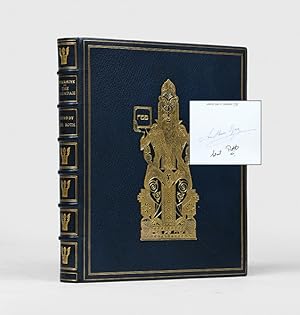
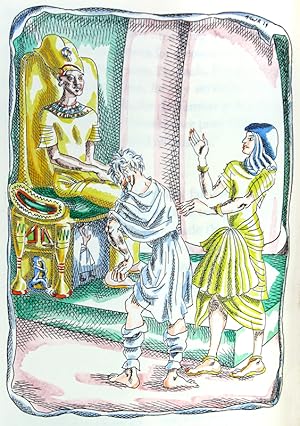

![Bild des Verkäufers für Seder Hagada [Haggadah hagadah] shel Pesakh [Pesach Pessach Pesah] zum Verkauf von Meir Turner](https://pictures.abebooks.com/inventory/md/md15148469196.jpg)
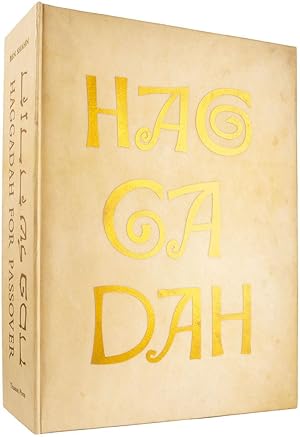
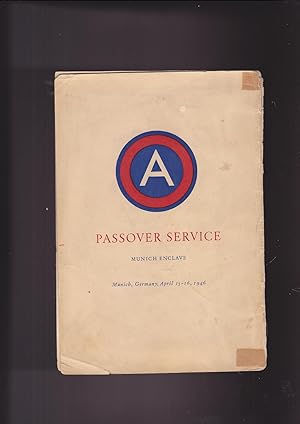
![Bild des Verkäufers für Lekhem Oni [Lehem Ohne] Peyrush al Haggadah shel Pesach [Passover Hagadah] zum Verkauf von Meir Turner](https://pictures.abebooks.com/inventory/md/md15676233328.jpg)

![Bild des Verkäufers für Seder Hagada shel Pesakh im perush yafe vetziyurim naim mehaotot vehamoftim sheasa hakadosh barukh hu leavoteynu venosaf al ze [Passover Pesach Pessach Pesakh Haggadah Hagadah Haggada] zum Verkauf von Meir Turner](https://pictures.abebooks.com/inventory/md/md15177082116.jpg)

![Bild des Verkäufers für Haggadah [passover haggada hagada hagadah shel pesach] zum Verkauf von Meir Turner](https://pictures.abebooks.com/inventory/md/md9947002651.jpg)
![Bild des Verkäufers für seder Haggadah shel Pesach [etc.] di hagode iz vern in Taitch geshtelt zum Verkauf von Meir Turner](https://pictures.abebooks.com/inventory/md/md14999254474.jpg)
![Bild des Verkäufers für Seder Hagada shel Pesach keminhag kehilat kodesh Sefaradim [Haggadah shel pesach passover hagada hagadah] zum Verkauf von Meir Turner](https://pictures.abebooks.com/inventory/md/md15035159917.jpg)
![Bild des Verkäufers für Seder Haggadah shel Pesach. [London Haggadah]. zum Verkauf von Shapero Rare Books](https://pictures.abebooks.com/inventory/md/md30581330746.jpg)
![Bild des Verkäufers für seder Haggadah shel Pesach [Passover Hagada,] zum Verkauf von Meir Turner](https://pictures.abebooks.com/inventory/md/md12803538869.jpg)
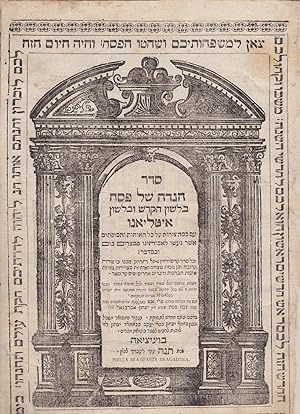
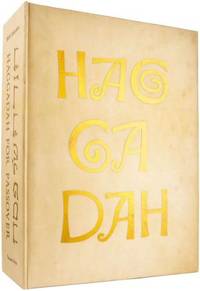


![Bild des Verkäufers für The Szyk Haggadah, Premier Edition [WITH AN ADDITION BOX OF SZYK MATERIAL] zum Verkauf von ERIC CHAIM KLINE, BOOKSELLER (ABAA ILAB)](https://pictures.abebooks.com/inventory/md/md30574855890.jpg)

![Bild des Verkäufers für Seder Hagada Bilshon HaKodesh veIm Perush shel Marathi [= Passover Haggadah in Hebrew with Marathi translation] zum Verkauf von Meir Turner](https://pictures.abebooks.com/inventory/md/md18671562427.jpg)
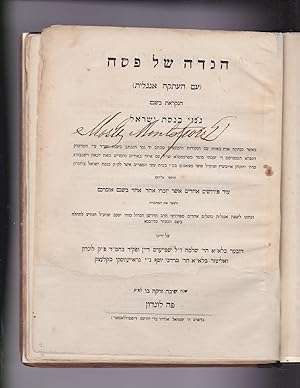
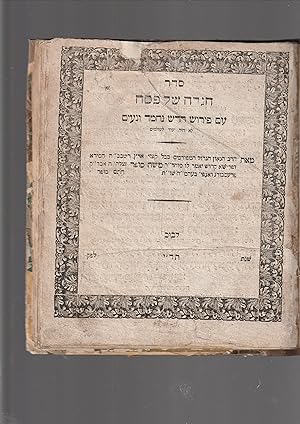
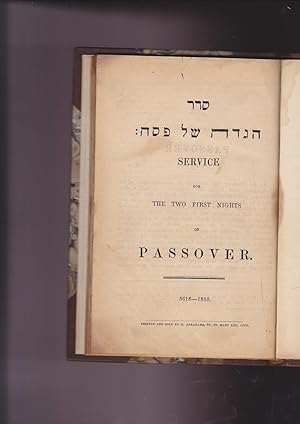
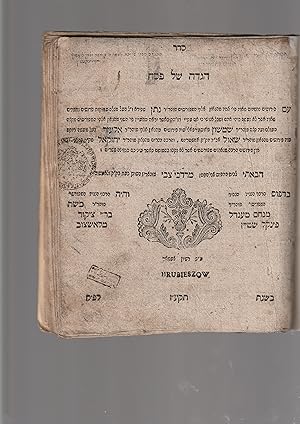
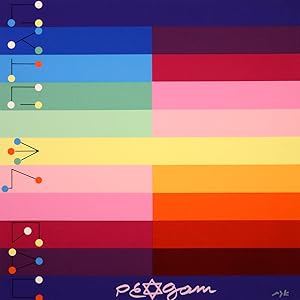
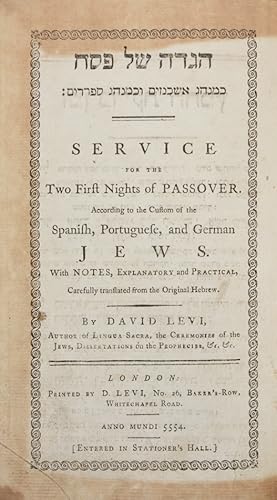
![Bild des Verkäufers für Ma'aleh Beit Horin ve'hu Seder Haggadah shel Pesach. [Passover Haggadah]. zum Verkauf von Shapero Rare Books](https://pictures.abebooks.com/inventory/md/md31529321628.jpg)
